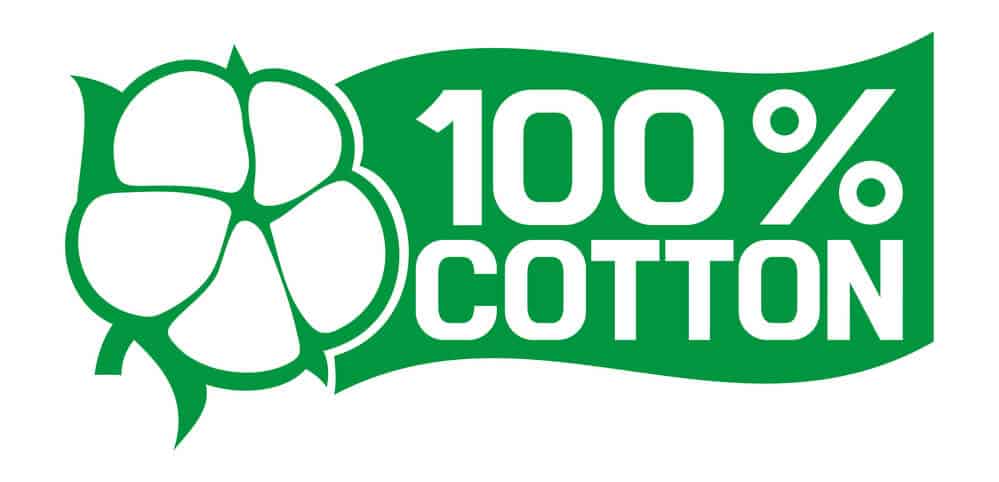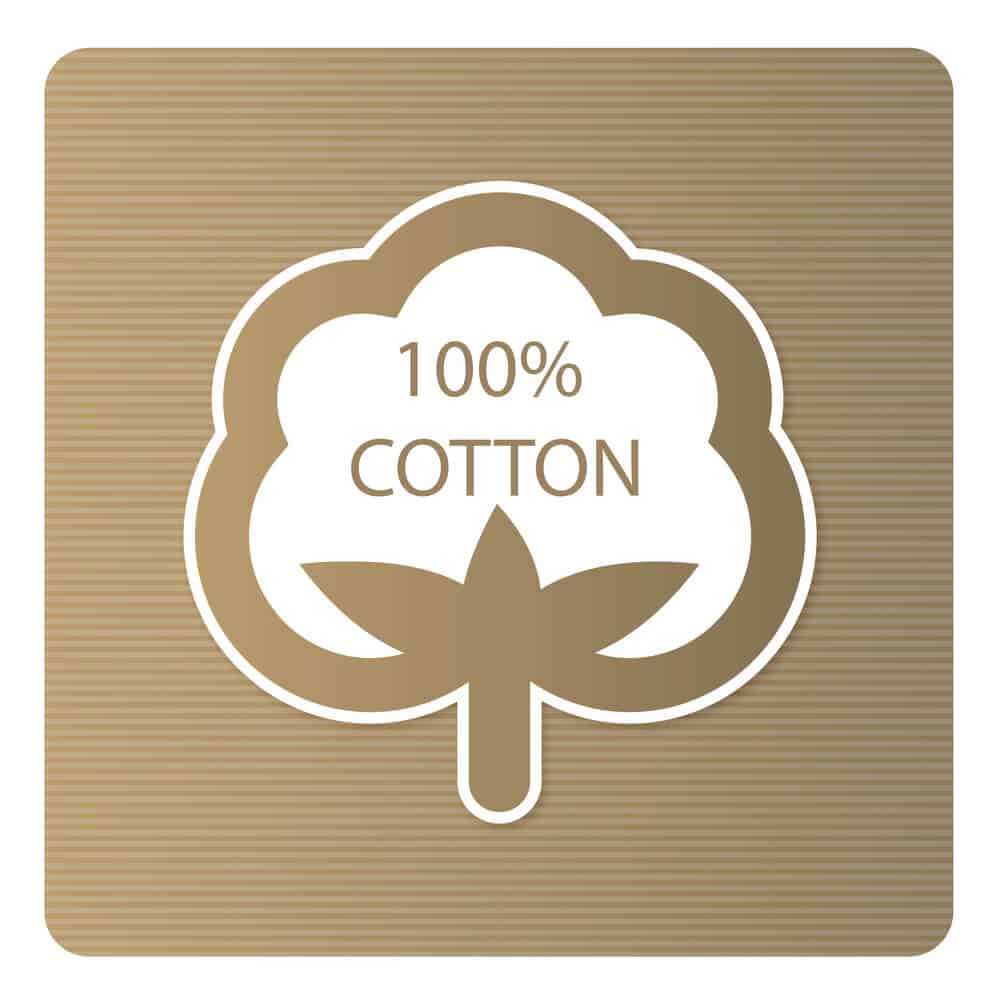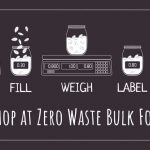Cotton is one of those resources that everyone knows about, but few people really understand.
Most of the world goes about their lives never wondering where their cotton jeans came from or if they were produced sustainably.
In the world we live in today, with global warming and increasingly scarce resources it is important to hold on to the resources we have.
It is also important to make them as sustainable as possible.
Cotton is sustainable in many ways. It is all-natural, and it can be reused, recycled, and biodegraded.
The process for growing cotton and making cotton things is less sustainable. The good news is that this is starting to change.
What Makes Cotton Sustainable?
Cotton is a fiber that is 100% natural. It can grow in several different climates and is quite easy to harvest.
Fabric made from cotton is breathable, absorbent, washable, and strong.
Cotton can be recycled and made into new garments or yarn.
Items made from cotton can also be reused.
For instance, old t-shirts make great rags for cleaning.
Cotton can be made into a number of different textured fabrics, from soft sweaters to jeans.
It is also easy to mix it with other fibers to make unique blends of fabrics.
Cotton is also biodegradable. When it can no longer be reused or recycled it can be biodegraded.
What Makes Cotton Unsustainable?
Unfortunately, while Cotton the plant is a sustainable resource, the practices used by most cotton growing businesses and clothing making businesses are not sustainable.
Cotton Growing ; Sustainability
Conventional Cotton growers use pesticides and fertilizers to grow their crops.
Most of these pesticides and fertilizers are chemical-based and bad for the environment.
Pesticide’s leach into the ground water and cause water pollution. This can and does harm the ecosystems downstream from cotton farms.
In addition, pesticides may be affecting the workers in the fields and people living downstream who drink water from local reservoirs.
A lot of water is used in the growing of cotton.
This water is then contaminated by pesticides and fertilizers making it unfit for consumption by humans or animals.
Cotton is a plant that leaches nutrients out of the soil. This impacts soil quality and that impacts the plants health.
When fields become too degraded, farmers typically expand and start a new field.
This in turn leads to loss of habitat for wild animals and destroys fragile ecosystems.
Lastly, most conventional companies use machines to pick cotton.
While machines are faster and cheaper than hand picking, they use gas or petrol and pollute the environment.
Sustainability; Turning Cotton into Things
Growing cotton is not the only area of the cotton industry that needs some work.
Businesses that turn cotton into fabric also need to become more sustainable.
Once picked, it has to be washed.
This is another water heavy process in the cotton cycle. Cotton is then rolled into bales by machines.
After that, cotton is loaded onto trucks and carried to the next destination.
Most of these trucks run on another important and scarce resource: gasoline.
Once at the factory, cotton goes through many processes of washing, dying, being turned into fabric, and lastly turned into whatever fabric or item it is being made into.
The machines in the factories that make the clothing, stuffed animal, or fabric have to be powered by something.
Depending on where you are in the world, they can be powered by electricity, gas, or coal.
In addition, working conditions in factories can be terrible.
You may have heard of “sweat-shops”, this term refers to some of the worst clothing making practices.

How Can Cotton Be Made More Sustainably?
Some things are already being done to make cotton more sustainable.
Organic Cotton, for example, does not use pesticides.
In addition, Farmers need to find ways to use less freshwater and use it more efficiently, find ways to support soil nutrient regeneration, and preserve the quality of the fiber.
The good news is that these things and more are already being done by many sustainably minded farmers across the globe.
One of the ways people are making a difference is by supporting causes like the Better Cotton Initiative.
These causes help bring awareness of the problems as well as supporting smaller farmers who want to be sustainable.
What is the Better Cotton Initiative?
The Better Cotton Initiative started out as a project to promote better ways of growing cotton.
It was so successful it became its own non-profit organization.
The Better Cotton Initiative supports and trains farmers in better cotton growing practices, assess farms and makes sure they are following the BCI guidelines, and monitors and evaluates changes being implemented as well as advances in technology that might be helpful.
Farms that work with the Better Cotton Initiative account for about 22% of all cotton in the world.
Companies that work with the Better Cotton Initiative include Nike, H;M, Levi Strauss ; Co, IKEA, M;S, and other globally recognized brands.
If you are interested in checking which companies are partnered with the Better Cotton Initiative here is a complete list.
What Fabrics Are Sustainable
There is no such thing as a 100% sustainable fabric.
However, some fabrics are more sustainable than others.
One way to ensure you are purchasing sustainable products is to check for the Better Cotton Initiative Logo or the Global Organic Textile Standard Logo.
Both of these groups promote sustainable practices.
Least Sustainable:
- Polyester
- Acrylic
- Nylon
- Rayon
- Conventional Cotton
- Conventional Bamboo
- Conventional Wool
- Conventional Down
- Conventional Leather
- Conventional Cashmere
- Viscose
- Modal
- Vegan Leather
- Synthetic Fibers
More Sustainable
- Organic or Recycled Cotton
- Organic and Sustainable Bamboo
- Organic Hemp
- Organic Linen
- Tencel/Lyocell
- Recycled Polyester
- Recycled Nylon
- Ramie
- Natural Rubber
- Recycled Wool or Responsible Wool
- Recycled Textiles
- Alpaca
- Silk
- Responsible Cashmere
- Responsible Leather
- Responsible Down
- Orange Fiber
- Pineapple Fiber
- Sustainable Viscose
- Cupro
Least Sustainable Fabrics and Textiles
Fabrics and textiles fall into the category of least sustainable for a variety of reasons. They can be on this list because the farming practices are not sustainable.
They can also be on this list because they are made from unnatural, chemical, or otherwise potentially toxic ingredients.
● Polyester
Polyester is a man-made textile that is a kind of plastic.
Polyester, like other plastics, is made from a non-renewable and unsustainable carbon-intensive resource: most commonly known as petroleum.
As a plastic, Polyester is subject to another unfortunate characteristic of plastics and that is that it is not biodegradable nor is it compostable.
It can also release toxic chemicals and dangerous microplastics into the environment.
In addition, the dyes used most commonly on polyester are toxic to the environment.
● Acrylic
The production of acrylic fabrics is a highly toxic and dangerous process.
It is dangerous and toxic not only to the environment but also to the workers.
Acrylic, like polyester, is a man-made plastic material.
It also releases harmful microplastics into the environment and it is not biodegradable or compostable.
● Nylon
Nylon is another plastic derived fabric. Similar to acrylic fabrics and polyester fabrics it is not biodegradable or compostable.
The creation of Nylon uses not only petroleum, but it also releases Nitrous oxide, one of the greenhouse gasses causing global warming.
The production of nylon uses large amounts of energy and water.
Lastly, like acrylic and polyester fabrics, nylon releases dangerous microplastics into the environment.
● Rayon
Rayon is made from plant cellulose that has been dissolved and then spun into thread.
It is biodegradable since it is made from plants and the material itself is non-toxic.
The sustainability problem appears when you look at how much water and energy is needed to produce Rayon.
In addition, the chemicals used in the rayon making process are toxic.
When the rayon is rinsed after being made these chemicals are then washed into streams and other fresh water sources.
Lastly, as the demand for rayon grows, so does the demand for plants to make rayon.
This is leading to deforestation in many areas.
Deforestation, in turn, leads to the endangerment of animals who call those forests home.
● Conventional Bamboo
While the growing process of bamboo is fairly sustainable, the making of bamboo fabrics is less so.
Conventional methods for making bamboo fabrics are very similar to the making of rayon.
● Conventional Wool
The negatives to wool come from the carbon footprint of animals whose fleece is used to make wool.
While this carbon footprint is a fraction of other carbon footprints it does still exist.
Other concerns include the overgrazing of sheep and similar animals in certain areas of the world.
Overgrazing can destroy a delicate ecosystem.
Many wool products also contain harmful or unnatural dyes or finishes.
When purchasing wool fabrics make sure to research the company and their methods of making and dying wool.
More Sustainable Fabrics and Textiles
Fabrics and textiles fall into this category if they are either naturally more sustainable or can be made more sustainably.
● Organic and Sustainable Bamboo
Organic and sustainably grown bamboo is an option for a fabric.
It is all-natural and biodegradable.
The bamboo plant is high yielding, grows fast, and is resilient.
When grown and produced using sustainable methods bamboo is a great option.
Unfortunately, not all companies that turn bamboo into a fabric do so sustainably.
Make sure to do your research before you buy bamboo clothing.
● Organic Hemp
Organic hemp is a popular sustainable alternative because it is quite durable.
It is also biodegradable since it is made from a plant
The hemp plant is resilient and requires little water to grow.
Unlike cotton it returns over 50% of nutrients to the soil it lives in.
While some manufacturers use chemicals to speed up the process of turning hemp into fabric, most do not.
Organically grown hemp which is then made without chemicals is a safe and sustainable fabric option.
In addition, the hemp plant not only provides hemp for clothing but also hemp seeds which are a food.
Seeds are not used in the clothing production so a hemp plant can be used for two purposes.
● Organic Linen
Organic Linen is made from the flax plant. Similar to hemp, this plant does not require a lot of water.
Linen is biodegradable because it is made from a plant.
The process to make linen is mechanically intensive which does mean it uses quite a bit of energy.
However, the process is not water intensive and therefore does not deplete that particular necessary resource.
While the linen making process does release carbon emissions, they are significantly less overall than most fabrics.
The process for making linen is a high yield process.
The flax plant also provides seed that are sold in stores as food.
● Tencel/Lyocell
Tencel is a relatively new fabric.
It is made from wood pulp and is similar to rayon. As it is made from trees it is biodegradable.
The process for making tencel was created to be more sustainable and environmentally friendly than that of making rayon.
Tencel uses ⅓ the water that rayon uses. In addition, the water and solvents used to make tencel are recyclable.
While not commonly available yet, tencel is growing as an industry.
● Recycled Polyester
Recycled Polyester still has the characteristics that will make it ultimately toxic to the environment.
However, by recycling polyester items or plastic items that can be recycled into polyester we are solving a world problem of too many plastics.
If you must get something polyester, try and buy something made from recycled polyester.
● Recycled Wool or Responsible Wool
Wool comes from sheep, goats, and other similar animals. Since it is an animal product it is biodegradable.
Wool is made from fleece which is essentially the fur or hair of the animal.
It regrows after shearing which makes it sustainable.
The biggest carbon footprint of wool comes from the sheep, goats, and animals the wool comes from.
The process of making fleece into wool uses nearly as little energy and has a nearly as small carbon footprint as hemp.
● Pineapple Fiber
Pineapple fiber from the leaves of pineapples is a very recent addition to the fabric industry.
It makes a durable fabric similar to leather.
Unlike leather, pineapple fiber does not require a lot of raw materials or chemicals.
It uses only non-toxic chemicals which can be reused multiple times to process the pineapple leaves.
While this fabric is promising, it has a bit of petroleum in it which prevents it from being biodegradable.
In addition, pineapple growing often leads to deforestation.
If this product becomes popular then more sustainable pineapple farming efforts will be needed.
Final Thoughts
Whether you are looking for a sustainable cotton or another sustainable option make sure you have all the facts before you buy.
Included below are a few websites with further information on sustainable farming, cotton, and other products.
Sources:


